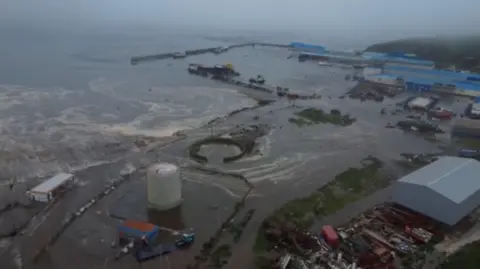On July 30, 2025, a tremendous earthquake measuring 8.8 on the Richter scale struck near the Kamchatka Peninsula in Russia, approximately at 11:25 AM local time (00:25 AM BST). This seismic event is recorded among the strongest earthquakes in history, triggering immediate tsunami warnings across the Pacific Region and resulting in significant evacuations in several nations.
In the aftermath of the earthquake, over two million residents from regions including Japan, Russia, and parts of the US West Coast were ordered to evacuate. Tsunami alerts were not only prompted in Japan and Russia but also extended to countries as far away as the Philippines, China, Indonesia, New Zealand, Peru, and Mexico. Each of these nations is on high alert, with officials keeping a close watch on wave patterns and potential impacts on coastal communities.
Footage from Severo-Kurilsk, a town on the Kuril Islands, shows waves up to 4 meters (13 feet) surging past buildings, flooding ports, and damaging fish processing facilities. Affected areas have experienced significant disruption, with vessels being tossed from their moorings and damage reported to power grids in Russia’s Sakhalin region.
In Japan, authorities made the decision for approximately 1.9 million residents to evacuate, urging them to seek higher ground. Initial tsunami waves arriving in Japan were smaller than projected, but Japanese officials remained cautious, warning that the waves could increase to approximately 3 meters (9.8 feet). Meanwhile, officials in Hawaii initially predicted waves could reach 10 feet as well, but later downgraded the tsunami warning to an advisory level, indicating that while strong currents and minor flooding could occur, a major tsunami at the moment was not expected. The Hawaii Emergency Management Agency stated that those who had evacuated could return home.
Despite fears of devastating consequences, the damage reported so far appears to be less severe than anticipated. Chris Goldfinger, a Professor of Marine Geology at Oregon State University, discussed ongoing scientific analysis aimed at refining damage forecasts, explaining that the impact can vary significantly depending on geographical factors specific to each location. He noted that areas southeast of the epicenter near Kamchatka would likely experience the most severe effects.
The tsunami waves from the earthquake reached parts of North America’s west coast around 12:20 AM local time (09:20 AM BST), with areas such as the Port of Tacoma in Washington and Nome, Alaska, expected to be affected later. As noted by Helen Janiszewski, an assistant professor in geophysics at the University of Hawaii, tsunami waves can travel at jet plane speeds, meaning they reach distant shores relatively quickly.
The earthquake’s depth is noted as comparatively shallow at approximately 19.3 kilometers (12 miles), and scientists from the US Geological Survey initially recorded it at an 8.0 magnitude before adjusting it to the more severe 8.8 after subsequent analysis and aftershocks. Comparatively, it ranks as one of the sixth strongest earthquakes recorded, linked to historical quakes such as the 2010 Biobío earthquake in Chile and the 1906 Esmeraldas earthquake in Ecuador. Remarkably, the 2004 Indian Ocean tsunami, which resulted in catastrophic losses, was recorded at a 9.2-9.3 magnitude and struck in a densely populated region.
The geographical context of Kamchatka—a sparsely populated region—may mitigate the loss of life compared to other devastating earthquakes recorded in history. However, the full extent of the tsunami’s impact continues to unfold, and officials are diligently monitoring the situation to ensure the safety and wellbeing of populations in the affected areas. As communities work to recover from this seismic event, they remain in a state of vigilant readiness for evolving conditions along the Pacific coastlines.












